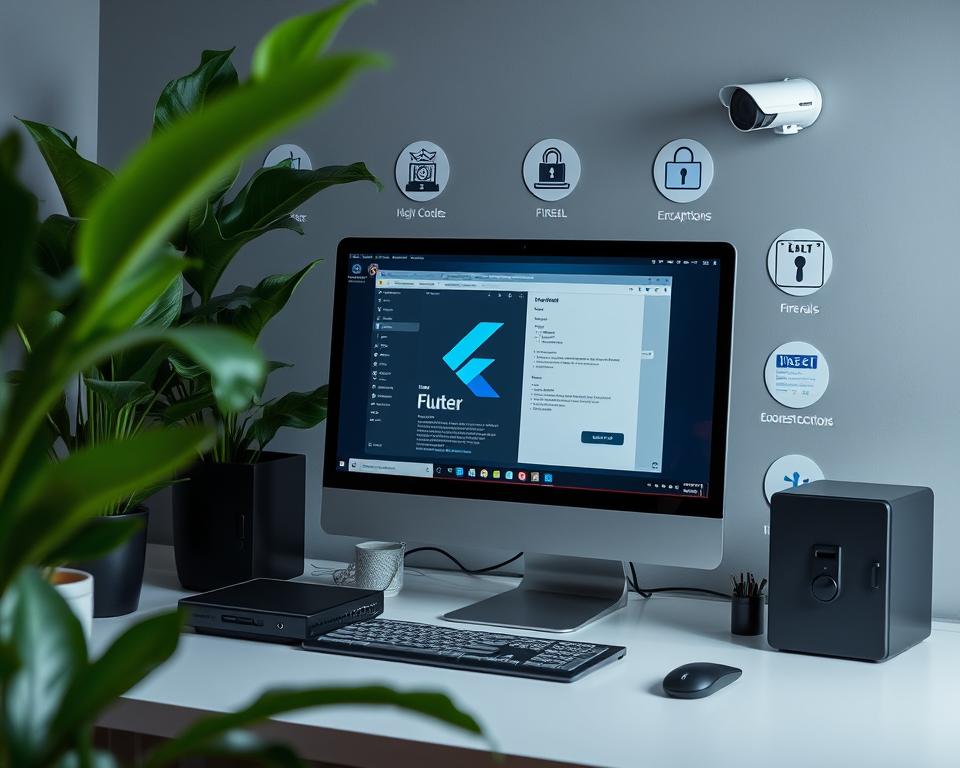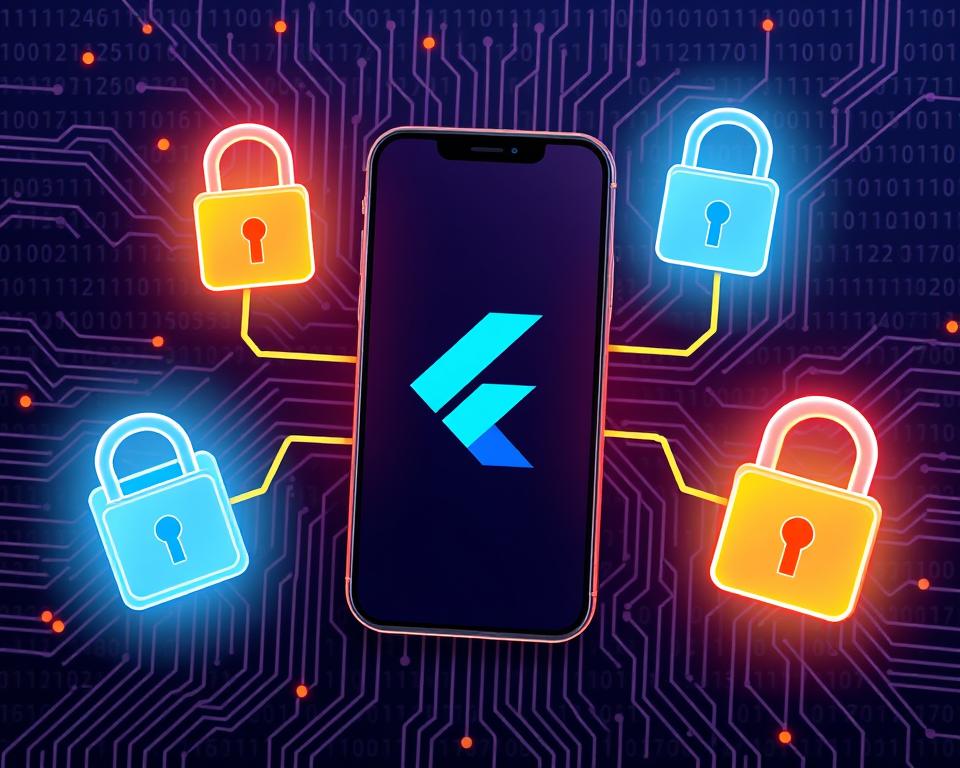In today’s world, keeping mobile apps safe is key. As a Flutter developer, protecting your users’ data is a big job. This guide will show you how to keep your apps safe from threats.
Flutter is a fast-growing tool for making mobile apps. It’s easy to use and works on many platforms. But, you must focus on security to keep your app and users safe. We’ll cover the basics of Flutter app security, common risks, and how to fix them.
Table of Contents
Key Takeaways
- Understand the importance of mobile app security and its impact on user trust and app success.
- Identify and mitigate common security vulnerabilities found in Flutter apps.
- Implement secure development practices, including secure coding, authentication, and data protection.
- Leverage Flutter’s security features and best practices to enhance app security.
- Conduct thorough security testing and vulnerability assessments to ensure a robust security posture.
Understanding Flutter App Security Fundamentals
Mobile app development is always changing, and security is key. Flutter, a popular framework for making mobile apps, needs strong security. Knowing about mobile app vulnerabilities and Flutter security is vital for developers.
Common Security Vulnerabilities in Mobile Apps
Mobile apps face many security risks. These include data leaks, insecure storage, and weak login systems. These issues can expose user data and harm the app’s safety.
Why Flutter Security Matters
Flutter is becoming more popular, making it a target for hackers. It’s important to secure Flutter apps to protect user data and keep the app safe. Weak spots in Flutter apps can let hackers in, putting user info at risk.
Security Best Practices Overview
- Use strong login methods like biometrics or multi-factor authentication.
- Encrypt data both when it’s stored and when it’s being sent, using SSL/TLS.
- Use code obfuscation and anti-tampering to keep the app’s code safe.
- Do regular security checks to find and fix weak spots.
- Keep up with the latest security tips and guidelines for app development.
By knowing the basics of security and following best practices, Flutter developers can make safe apps. These apps will protect user data and keep the app working well.
“Security should be a top priority in any mobile app development process, and Flutter is no exception. Neglecting security can have severe consequences, including data breaches, system compromises, and reputational damage.”
Setting Up Secure Development Environment
Creating a secure Flutter app begins with a solid foundation. This foundation is built by setting up a secure development environment. It involves configuring your IDE and using strong version control practices. Each step is crucial for your app’s security.
Securing Your Flutter IDE
Your Flutter IDE, like Android Studio or Visual Studio Code, is key. Make sure it’s updated with the latest security patches. Also, keep all plugins and extensions current. This keeps your coding space safe from threats.
Embracing Secure Version Control
Version control systems, like Git, are vital for teamwork and security. Use strong passwords, check access rights often, and follow secure branching rules. These steps protect your code from unauthorized changes.
Maintaining Code Integrity
Keeping your code safe is essential. Use tools for Flutter IDE security like static code checks and dependency management. Also, set up CI/CD pipelines. These tools find and fix security issues early.
Creating a secure development environment is the first step to a safe Flutter app. Security is an ongoing effort. Regular updates, audits, and proactive steps protect your app and its users.
How to Secure Your Flutter App: Essential Steps
Securing your Flutter app is key to protect your users’ sensitive info and keep their trust. We’ll cover the main steps to make your app safe from threats.
Authentication Implementation
Strong authentication is the base of a secure app. Use Flutter authentication methods like password hashing and secure token storage. Also, add multi-factor authentication to check user identities and block unauthorized access.
Authorization Methods
Good app authorization controls are vital for managing user permissions. Use role-based access control (RBAC) or attribute-based access control (ABAC). This way, users can only do what they’re allowed to and see the data they should.
Data Protection Strategies
Protecting user data is a top priority. Use data protection techniques like end-to-end encryption and secure data storage. Also, anonymize data to prevent breaches. Always update your data protection plans to keep up with new security threats.
“Securing your Flutter app is not just about compliance, it’s about building trust with your users and protecting their valuable data.”
By taking these steps, you can make your Flutter app strong and keep your users’ sensitive info safe.
Implementing Secure Data Storage
In Flutter app development, keeping user data safe is key. We must protect the information users share with us. This includes using secure data storage methods. We’ll explore how to make your Flutter app’s data secure.
Encrypted Storage for Local Data
Encryption is vital for local data on a user’s device. Flutter has strong encryption libraries, like the encrypt package. These tools help keep your users’ data safe, even if their device is hacked.
Securing SharedPreferences
Secure SharedPreferences is important in Flutter apps. It’s a simple way to store and get data. But, it must be set up securely to protect the data.
Flutter Database Security
For big data or complex needs, Flutter uses databases. It’s key to secure these databases. This means protecting connections, controlling access, and encrypting data.
“Securing data storage is the foundation of a truly robust Flutter app. By implementing the right techniques, you can protect your users’ sensitive information and build trust in your application.”
Learning these secure data storage practices is crucial. It helps protect user privacy and follow data protection laws. With the right steps, you can create Flutter apps that users trust and rely on.
Network Security and API Protection
As Flutter developers, we must focus on keeping our app’s network and API safe. It’s key in today’s world where cyber threats keep changing. We need strong steps to protect these important parts.
SSL/TLS Implementation
Using SSL/TLS to secure network traffic is a must for your Flutter app. It encrypts data between your app and the server. This stops others from listening in and keeps your data safe. Make sure to use the latest SSL/TLS settings and strong encryption.
API Authentication Methods
Keeping your app’s API safe is also vital. Use strong API security like tokens or OAuth 2.0. This keeps your app safe from unauthorized access and data theft. Always check and update your security methods to fight new threats.
Certificate Pinning Techniques
Adding SSL pinning to your Flutter app boosts security. It means your app only talks to the right servers. This stops hackers from getting in the middle and makes your app safer.
By using these security steps, you make your Flutter app much safer. Protect your users’ data well. Always keep your security up-to-date and watch over your app’s network.
Code Obfuscation and Anti-Tampering Measures
Protecting your Flutter app’s source code is key in today’s digital world. Using code obfuscation techniques helps keep your app’s inner workings hidden. This stops unauthorized access and keeps your app integrity safe. It also blocks anti-reverse engineering efforts.
Code obfuscation is a main way to protect your Flutter app. It makes your app’s source code hard to understand for hackers. By changing variable names and method signatures, you make it tough for them to reverse engineer your app.
- Use tools like ProGuard or R8 to make your Flutter code unreadable and hard to tamper with.
- Apply control flow obfuscation to mess up your app’s logic, making reverse engineering harder.
- Use string obfuscation to hide sensitive info like API keys or authentication tokens in your code.
Adding anti-tampering measures is also key to protect your Flutter app. These measures spot and stop any attempts to change your app. They make sure any unauthorized changes are caught and fixed quickly.
| Technique | Description |
|---|---|
| Integrity Checks | Use checksums to check if your app’s files have been changed or tampered with. |
| Tamper-Evident Packaging | Use solutions that show if someone has tried to change your app’s package. |
| Runtime Monitoring | Watch your app’s behavior and catch any signs of tampering. |
By mixing code obfuscation and anti-tampering measures, you get a strong security plan. This plan keeps your Flutter app’s app integrity safe and stops anti-reverse engineering efforts. This approach keeps your Flutter apps secure and reliable for a long time.
“Securing your Flutter app’s source code is a critical step in maintaining its integrity and trustworthiness in the face of modern security threats.”
Secure Authentication Implementation
In the world of mobile app development, security is key. Flutter apps are no different. To make your Flutter app’s login process strong, use advanced methods like biometric authentication, multi-factor authentication (MFA), and secure OAuth integration.
Biometric Authentication
Biometric methods like fingerprint or facial recognition make logging in easy and safe. By adding Flutter biometrics, you add an extra layer of security. This helps keep your app safe from unauthorized access.
Multi-Factor Authentication
Adding MFA implementation boosts your app’s security. It asks for more than one way to prove who you are. For example, a password and a code sent to your phone. This makes it harder for others to get in.
OAuth Integration
Using OAuth security in your Flutter app makes logging in easy and safe. It lets users log in with accounts they already have, like Google or Facebook. This makes logging in smooth and secure.
| Authentication Method | Advantages | Considerations |
|---|---|---|
| Biometric Authentication |
|
|
| Multi-Factor Authentication |
|
|
| OAuth Integration |
|
|
By using these secure login methods in your Flutter app, you offer a safe and easy way to log in. This protects your users’ personal info.
Protecting Sensitive Data in Transit
In today’s digital world, keeping sensitive data safe while it’s being sent is key for any Flutter app. This includes personal info, money transactions, and confidential business data. We’ll look at how to keep your app’s data safe, like using encryption, secure API talks, and following network security tips.
Data Encryption: The Foundation of Secure Data Transmission
Data encryption is the main way to keep data safe while it’s being sent. It makes sure your app’s data stays secret and safe, even if someone tries to get it. You need to use strong encryption, keep encryption keys safe, and encrypt data before it goes out.
Secure API Communications: Safeguarding Your App’s Integrations
It’s also important to make sure your Flutter app talks securely with other services or APIs. Use strong ways to check who you’re talking to, like OAuth 2.0 or API keys. Also, use certificate pinning to stop bad guys from messing with your API talks.
Comprehensive Flutter Network Security
Keeping data safe also means looking at the whole picture of Flutter network security. Make sure your app’s internet connections are safe with the latest SSL/TLS. Watch for network attacks, and have good ways to handle errors and logs to catch and fix security problems.
| Security Measure | Description | Importance |
|---|---|---|
| Data Encryption | Implementing end-to-end encryption to protect data confidentiality during transmission | High |
| Secure API Communications | Securing API integrations through authentication, authorization, and integrity checks | High |
| Comprehensive Flutter Network Security | Ensuring secure network connections, monitoring for attacks, and implementing robust error handling | High |
By using these security tips, you can keep your Flutter app’s data safe while it’s being sent. This helps avoid data breaches and other security problems. Remember, strong encryption, secure API talks, and good network security are key for a safe Flutter app.
Implementing Secure File Operations
In the world of mobile app development, keeping user data safe is key. Flutter apps need strong security for file operations. This part talks about Flutter file encryption and secure file access controls to protect your app’s data.
File Encryption Methods
Encrypting files in Flutter stops unauthorized access and data breaches. Flutter uses libraries like encrypt and cryptography for strong encryption. These tools use AES and RSA to keep your app’s files safe, even if a device is lost or stolen.
Secure File Access Controls
Secure file handling in Flutter means setting up strong access controls. This limits file operations based on user permissions. By doing this, you can protect your app’s sensitive data and stop unauthorized access or tampering.
| Encryption Method | Key Features | Recommended Use Cases |
|---|---|---|
| AES (Advanced Encryption Standard) |
|
|
| RSA (Rivest-Shamir-Adleman) |
|
|
By using Flutter file encryption and secure file access controls, developers can keep their app’s data safe. This makes the app more secure and trustworthy for users.
Runtime Application Self-Protection (RASP)
In the world of mobile app security, Runtime Application Self-Protection (RASP) is key for Flutter apps. RASP helps your app spot and handle threats as they happen. This boosts runtime security and dynamic app protection.
Adding RASP to your Flutter app lets it watch its own actions. It finds odd behavior and acts fast to stop security risks. This way, your app stays safe, keeps data secure, and works right.
Key Benefits of RASP in Flutter Apps
- Continuous, in-app security monitoring to detect and address threats as they arise
- Real-time response and mitigation of security incidents, reducing the risk of successful attacks
- Enhanced protection for sensitive data, user information, and critical app functionalities
- Improved compliance with industry regulations and security standards
- Reduced reliance on external security tools and services, streamlining the development process
Using Flutter RASP makes your apps more secure. This keeps your users safe and protects your brand online.
| Feature | Description |
|---|---|
| Runtime Monitoring | Continuously monitors the app’s behavior and detects anomalies in real-time |
| Threat Detection | Identifies potential security threats, such as unauthorized access attempts, data leaks, and tampering |
| Automated Response | Triggers immediate, automated response mechanisms to mitigate identified threats |
| Reporting and Analytics | Provides detailed logs, reports, and analytics to help developers understand and address security issues |
With Flutter RASP, your apps get a big security boost. This keeps your users’ data safe, making your app a trusted place online.
“Integrating RASP into your Flutter app is a game-changer in the world of mobile security. It empowers your app to defend itself against real-time threats, providing an additional layer of protection that can’t be ignored.”
Security Testing and Vulnerability Assessment
Keeping your Flutter app safe is key during development. Security testing and vulnerability assessment help protect your users’ data. We’ll look at Flutter app penetration testing and security scanning tools to find and fix security vulnerabilities.
Penetration Testing Guidelines
Penetration testing simulates attacks on your Flutter app to find weak spots. It helps you see things from a hacker’s point of view. Here are some tips for good Flutter app penetration testing:
- Know what you’re testing: Pick specific areas like login, data storage, or network use.
- Use a tested method: Follow a framework like OWASP MASVS for a thorough test.
- Use special tools: Tools like Frida, Drozer, or OWASP ZAP help find more issues.
- Report and fix: Document and fix each found problem to keep your app safe.
Security Scanning Tools
Manual testing is good, but security scanning tools find more issues. These tools help you spot and report problems, saving time. Some top security scanning tools for Flutter apps are:
- OWASP ZAP (Zed Attack Proxy): A free tool for web and mobile app security.
- Burp Suite: A suite for web app security with deep features.
- Appium: A test framework for mobile apps, great for security checks.
- Frida: A tool for inspecting and changing app behavior.
Using penetration testing and security scanning tools makes your Flutter app safer. This ensures a detailed vulnerability assessment.
“Security is not a product, but a process. It’s about how you manage your systems.” – Bruce Schneier
Compliance and Regulatory Considerations
Creating a Flutter app means dealing with many rules and standards. It’s key to know the data protection laws and security rules for your app’s field or area. Not following these rules can lead to big fines, harm to your brand, and losing user trust.
The European Union’s GDPR and the U.S.’s HIPAA are big examples of data protection laws for Flutter app makers. These rules set clear rules for handling personal info, keeping data safe, and reporting breaches. Following these laws is not a choice; it’s a must for any app that deals with sensitive user data.
Flutter app developers also face specific security standards, like PCI DSS for apps that handle money or NIST’s Cybersecurity Framework for government apps. Keeping up with the latest security tips and using strong protection is vital. It helps keep your users’ trust and avoids legal trouble.



















